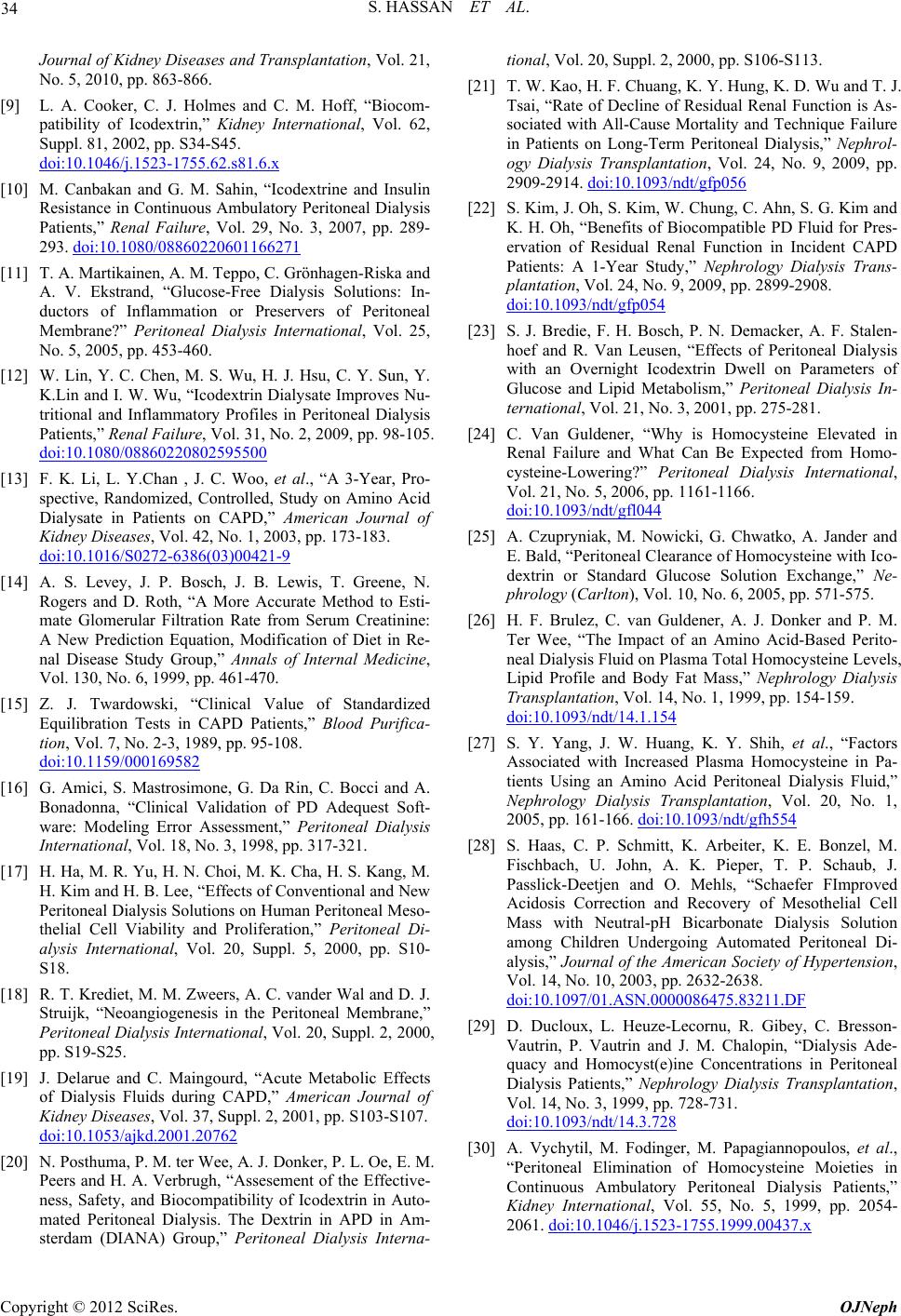
S. HASSAN ET AL.
Copyright © 2012 SciRes. OJNeph
34
Journal of Kidney Diseases and Transplantation, Vol. 21,
No. 5, 2010, pp. 863-866.
[9] L. A. Cooker, C. J. Holmes and C. M. Hoff, “Biocom-
patibility of Icodextrin,” Kidney International, Vol. 62,
Suppl. 81, 2002, pp. S34-S45.
doi:10.1046/j.1523-1755.62.s81.6.x
[10] M. Canbakan and G. M. Sahin, “Icodextrine and Insulin
Resistance in Continuous Ambulatory Peritoneal Dialysis
Patients,” Renal Failure, Vol. 29, No. 3, 2007, pp. 289-
293. doi:10.1080/08860220601166271
[11] T. A. Martikainen, A. M. Teppo, C. Grönhagen-Riska and
A. V. Ekstrand, “Glucose-Free Dialysis Solutions: In-
ductors of Inflammation or Preservers of Peritoneal
Membrane?” Peritoneal Dialysis International, Vol. 25,
No. 5, 2005, pp. 453-460.
[12] W. Lin, Y. C. Chen, M. S. Wu, H. J. Hsu, C. Y. Sun, Y.
K.Lin and I. W. Wu, “Icodextrin Dialysate Improves Nu-
tritional and Inflammatory Profiles in Peritoneal Dialysis
Patients,” Renal Failure, Vol. 31, No. 2, 2009, pp. 98-105.
doi:10.1080/08860220802595500
[13] F. K. Li, L. Y.Chan , J. C. Woo, et al., “A 3-Year, Pro-
spective, Randomized, Controlled, Study on Amino Acid
Dialysate in Patients on CAPD,” American Journal of
Kidney Diseases, Vol. 42, No. 1, 2003, pp. 173-183.
doi:10.1016/S0272-6386(03)00421-9
[14] A. S. Levey, J. P. Bosch, J. B. Lewis, T. Greene, N.
Rogers and D. Roth, “A More Accurate Method to Esti-
mate Glomerular Filtration Rate from Serum Creatinine:
A New Prediction Equation, Modification of Diet in Re-
nal Disease Study Group,” Annals of Internal Medicine,
Vol. 130, No. 6, 1999, pp. 461-470.
[15] Z. J. Twardowski, “Clinical Value of Standardized
Equilibration Tests in CAPD Patients,” Blood Purifica-
tion, Vol. 7, No. 2-3, 1989, pp. 95-108.
doi:10.1159/000169582
[16] G. Amici, S. Mastrosimone, G. Da Rin, C. Bocci and A.
Bonadonna, “Clinical Validation of PD Adequest Soft-
ware: Modeling Error Assessment,” Peritoneal Dialysis
International, Vol. 18, No. 3, 1998, pp. 317-321.
[17] H. Ha, M. R. Yu, H. N. Choi, M. K. Cha, H. S. Kang, M.
H. Kim and H. B. Lee, “Effects of Conventional and New
Peritoneal Dialysis Solutions on Human Peritoneal Meso-
thelial Cell Viability and Proliferation,” Peritoneal Di-
alysis International, Vol. 20, Suppl. 5, 2000, pp. S10-
S18.
[18] R. T. Krediet, M. M. Zweers, A. C. vander Wal and D. J.
Struijk, “Neoangiogenesis in the Peritoneal Membrane,”
Peritoneal Dialysis International, Vol. 20, Suppl. 2, 2000,
pp. S19-S25.
[19] J. Delarue and C. Maingourd, “Acute Metabolic Effects
of Dialysis Fluids during CAPD,” American Journal of
Kidney Diseases, Vol. 37, Suppl. 2, 2001, pp. S103-S107.
doi:10.1053/ajkd.2001.20762
[20] N. Posthuma, P. M. ter Wee, A. J. Donker, P. L. Oe, E. M.
Peers and H. A. Verbrugh, “Assesement of the Effective-
ness, Safety, and Biocompatibility of Icodextrin in Auto-
mated Peritoneal Dialysis. The Dextrin in APD in Am-
sterdam (DIANA) Group,” Peritoneal Dialysis Interna-
tional, Vol. 20, Suppl. 2, 2000, pp. S106-S113.
[21] T. W. Kao, H. F. Chuang, K. Y. Hung, K. D. Wu and T. J.
Tsai, “Rate of Decline of Residual Renal Function is As-
sociated with All-Cause Mortality and Technique Failure
in Patients on Long-Term Peritoneal Dialysis,” Nephrol-
ogy Dialysis Transplantation, Vol. 24, No. 9, 2009, pp.
2909-2914. doi:10.1093/ndt/gfp056
[22] S. Kim, J. Oh, S. Kim, W. Chung, C. Ahn, S. G. Kim and
K. H. Oh, “Benefits of Biocompatible PD Fluid for Pres-
ervation of Residual Renal Function in Incident CAPD
Patients: A 1-Year Study,” Nephrology Dialysis Trans-
plantation, Vol. 24, No. 9, 2009, pp. 2899-2908.
doi:10.1093/ndt/gfp054
[23] S. J. Bredie, F. H. Bosch, P. N. Demacker, A. F. Stalen-
hoef and R. Van Leusen, “Effects of Peritoneal Dialysis
with an Overnight Icodextrin Dwell on Parameters of
Glucose and Lipid Metabolism,” Peritoneal Dialysis In-
ternational, Vol. 21, No. 3, 2001, pp. 275-281.
[24] C. Van Guldener, “Why is Homocysteine Elevated in
Renal Failure and What Can Be Expected from Homo-
cysteine-Lowering?” Peritoneal Dialysis International,
Vol. 21, No. 5, 2006, pp. 1161-1166.
doi:10.1093/ndt/gfl044
[25] A. Czupryniak, M. Nowicki, G. Chwatko, A. Jander and
E. Bald, “Peritoneal Clearance of Homocysteine with Ico-
dextrin or Standard Glucose Solution Exchange,” Ne-
phrology (Carlton), Vol. 10, No. 6, 2005, pp. 571-575.
[26] H. F. Brulez, C. van Guldener, A. J. Donker and P. M.
Ter Wee, “The Impact of an Amino Acid-Based Perito-
neal Dialysis Fluid on Plasma Total Homocysteine Levels,
Lipid Profile and Body Fat Mass,” Nephrology Dialysis
Transplantation, Vol. 14, No. 1, 1999, pp. 154-159.
doi:10.1093/ndt/14.1.154
[27] S. Y. Yang, J. W. Huang, K. Y. Shih, et al., “Factors
Associated with Increased Plasma Homocysteine in Pa-
tients Using an Amino Acid Peritoneal Dialysis Fluid,”
Nephrology Dialysis Transplantation, Vol. 20, No. 1,
2005, pp. 161-166. doi:10.1093/ndt/gfh554
[28] S. Haas, C. P. Schmitt, K. Arbeiter, K. E. Bonzel, M.
Fischbach, U. John, A. K. Pieper, T. P. Schaub, J.
Passlick-Deetjen and O. Mehls, “Schaefer FImproved
Acidosis Correction and Recovery of Mesothelial Cell
Mass with Neutral-pH Bicarbonate Dialysis Solution
among Children Undergoing Automated Peritoneal Di-
alysis,” Journal of the American Society of Hypertension,
Vol. 14, No. 10, 2003, pp. 2632-2638.
doi:10.1097/01.ASN.0000086475.83211.DF
[29] D. Ducloux, L. Heuze-Lecornu, R. Gibey, C. Bresson-
Vautrin, P. Vautrin and J. M. Chalopin, “Dialysis Ade-
quacy and Homocyst(e)ine Concentrations in Peritoneal
Dialysis Patients,” Nephrology Dialysis Transplantation,
Vol. 14, No. 3, 1999, pp. 728-731.
doi:10.1093/ndt/14.3.728
[30] A. Vychytil, M. Fodinger, M. Papagiannopoulos, et al.,
“Peritoneal Elimination of Homocysteine Moieties in
Continuous Ambulatory Peritoneal Dialysis Patients,”
Kidney International, Vol. 55, No. 5, 1999, pp. 2054-
2061. doi:10.1046/j.1523-1755.1999.00437.x